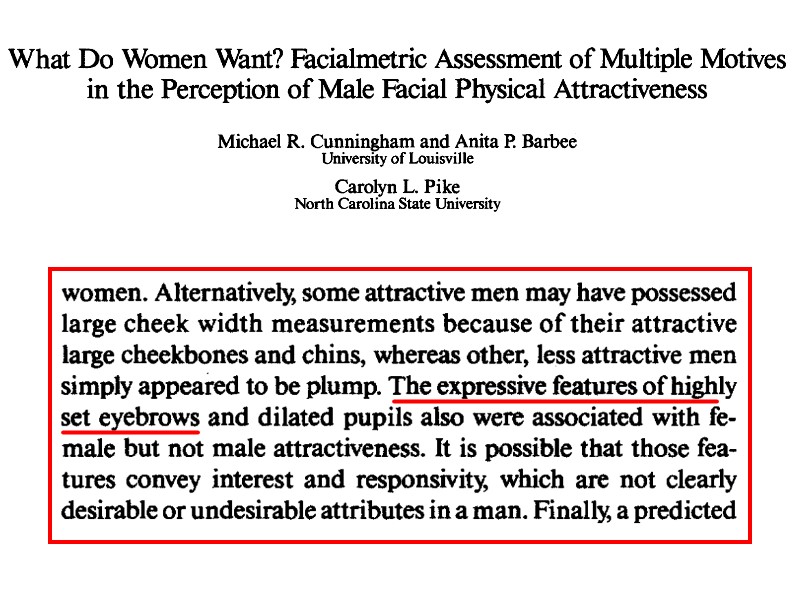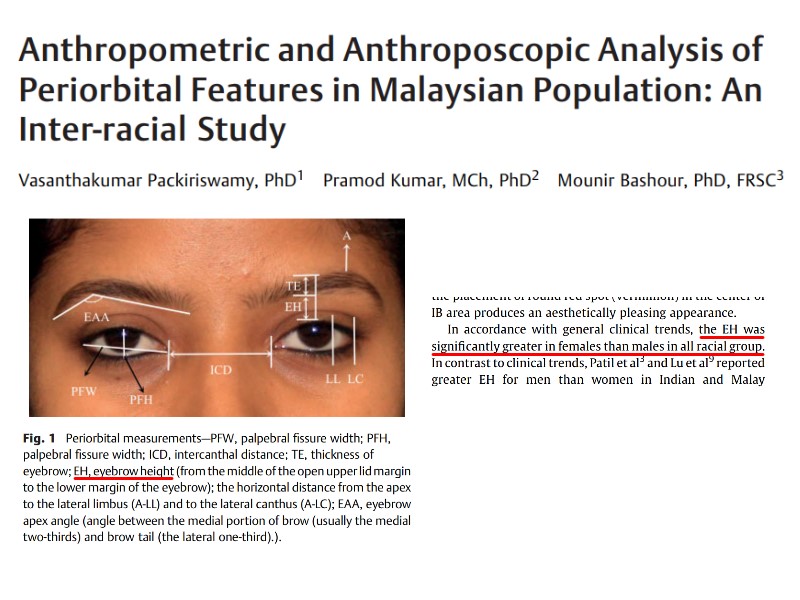Summary
A high eyebrow type is considered more attractive than a low eyebrow type among females. In a study, subjects from various age groups ranked high eyebrows as the most attractive, with low eyebrows receiving the least preference. According to a study, highly set eyebrows are associated with female features.
Two studies confirm that high-set eyebrows are a sexually dimorphic feature. Some found interbrow height to be significantly greater in females than males. Likewise, a study discovered eyebrow height to be significantly larger in women compared to men.
Furthermore, a research study explains that the attractiveness of eye-to-eyebrow distance is influenced by overall face shape. Shorter, rounder faces are considered most attractive with high-set, curved eyebrows, while square or longer faces are perceived as more attractive with lower-set, flatter eyebrows. This relationship suggests that ideal eyebrow placement varies with individual facial aesthetics.
Research
A study “Attractiveness of Eyebrow Position and Shape in Females Depends on the Age of the Beholder” conducted by Dominik K. Feser et el, Department of Plastic Surgery and Department of Experimental and Applied Psychology, University of Regensburg, Germany, interviews were conducted with individuals of different age groups with youngest experimental subject was 12 years old, and the oldest was 85 years of age. Altogether, 178 male and 179 female subjects questioned, and in each age group, the number of men and women was balanced. The subjects were instructed to rank each of the three variants according to their attractiveness. Overall, the subjects all judged the high eyebrow type to be the most attractive and the low eyebrow type received the lowest preference.

In his famous paper, Cunningham mentioned that the expressive features of highly set eyebrows were associated with female features.

To corroborate his finds, two studies mentioned below are finds the high set eyebrows are sexually diamorphic feature.
Packiriswamy et al. in their paper “Anthropometric and Anthroposcopic Analysis of Periorbital Features”, quantified the aesthetic dimensions and position of periorbital features. The study involved 300 male and 300 female subjects with ages ranging from 17 to 25 years. Standardised facial photographs of the subjects were taken in frontal view and the aesthetic dimensions and position of periorbital features including eyebrow height (EH) were measured using Image analyzer. The study demonstrated that interbrow height was significantly greater in females than males (p<0.005).

In a study carried out by Price et al. “Eyebrow and eyelid dimensions: An anthropometric analysis”, ideal eyebrow and eyelid dimensions were studied among 68 male and female subjects, divided into three age cohorts (20 to 39 years, 40 to 59 years, and 60 to 79 years) and by gender. The subjects were then photographed in the frontal view with brow fixation, first with eyes open in primary gaze, and then with eyes gently closed. The standardised digital images were then analysed using a measuring software. It was found that eyebrow height was significantly larger in women than men (p<0.001).
The scientists Zhao et al in their study “Data-Driven Research on the Matching Degree of Eyes, Eyebrows and Face Shapes”, go on to explain that although eye to eyebrow distance does serve as a proxy for female attractiveness, it is heavily influenced by overall face shape. Shorter, rounder faces are scored as most attractive when they have high set (or more distal) eyebrows with a higher degree of curvature. Whereas square or longer faces are considered most attractive with exactly the opposite: lower set, flatter eyebrows (Zhao et al, 2019; Baker, 2007). The eye to eyebrow distance and shape can accentuate other attractive facial features, slim the overall facial appearance and alter the perception of eye size but the bi-directionality of this relationship means that the ideal eyebrow placement varies with individual facial aesthetics.

References:
“Attractiveness of Eyebrow Position and Shape in Females Depends on the Age of the Beholder” by Dominik K. Feser at el, Department of Plastic Surgery, University of Regensburg, Germany https://link.springer.com/article/10.1007/s00266-006-0149-x
Cunningham, M. R., Barbee, A. P., & Pike, C. L. (1990), University of Louisville. What do women want? Facialmetric assessment of multiple motives in the perception of male facial physical attractiveness. Journal of personality and social psychology, 59(1), 61. https://pubmed.ncbi.nlm.nih.gov/2213490/
Packiriswamy, V., Kumar, P. and Bashour, M. (2018) ‘Anthropometric and Anthroposcopic Analysis of Periorbital Features in Malaysian Population: An Inter-racial Study’, Facial Plastic Surgery, 34(4), pp. 400–406. doi: 10.1055/s-0038-1648224. https://pubmed.ncbi.nlm.nih.gov/29723879/
Price, K. M. et al. (2009) ‘Eyebrow and eyelid dimensions: An anthropometric analysis of African Americans and Caucasians’, Plastic and Reconstructive Surgery, 124(2), pp. 615–623. doi: 10.1097/PRS.0b013e3181addc98. https://pubmed.ncbi.nlm.nih.gov/19644282/
Zhao, J., Zhang, M., He, C., & Zuo, K. (2019). Data-Driven Research on the Matching Degree of Eyes, Eyebrows and Face Shapes. Frontiers in Psychology, 10, 1466. https://pubmed.ncbi.nlm.nih.gov/31333533/
Baker, S B., Dayan, J H., Crane, A., Kim, S., (2007). The Influence of Brow Shape on the Perception of Facial Form and Brow Aesthetics. Plastic and Reconstructive Surgery, 119(7), 2240–2247. https://pubmed.ncbi.nlm.nih.gov/17519727/

